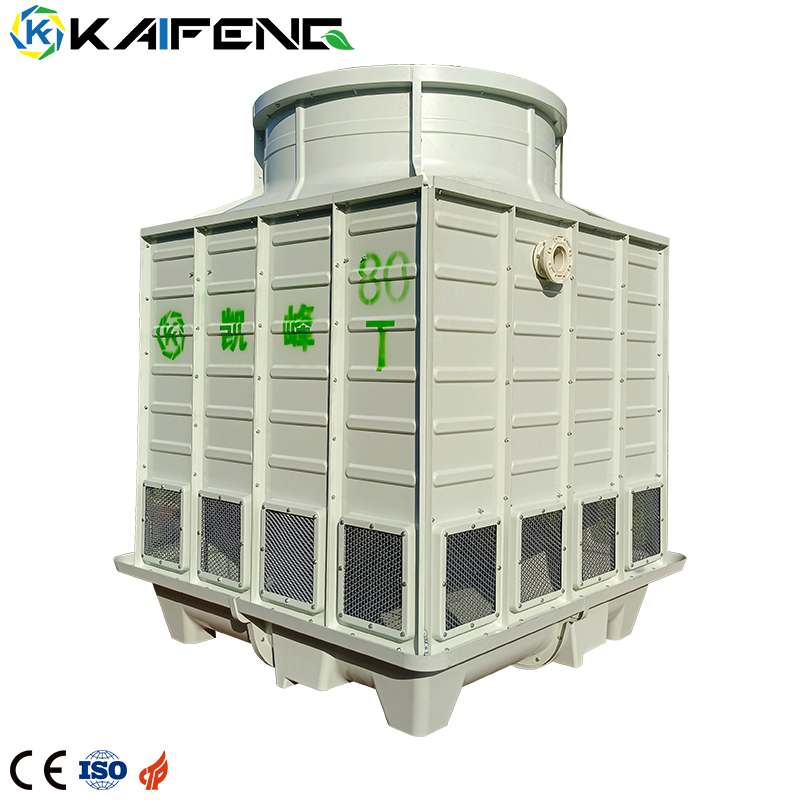Square cooling tower
Water is filled in the cooling tower, the water flows from top to bottom, and the air flows horizontally from the outside of the tower to the inside of the tower, and the two flow directions are vertical and orthogonal to a cooling tower. Commonly used in residential areas with strict noise requirements, it is a cooling cycle tower that is widely used in the air-conditioning industry.
Features:
1. High efficiency and low drift
The water spray packing has high heat dissipation efficiency, small wind resistance coefficient and long service life. The water distribution system adopts large-diameter non-blocking nozzles to ensure uniform water distribution.
2. Long service life
The tower body is made of reinforced glass fiber reinforced plastic, which will not corrode and reduce maintenance and repair costs. All tower supports are made of heavy-gauge steel and are hot-dipped galvanized for durability.
3. Low noise, fan
The low-speed axial flow fan of the cooling tower is adopted, and the installation angle can be changed to meet different efficiency requirements.
4. Easy to assemble
Combination type, light accessories, easy to transport and install.
Three stages of cooling tower
1. Send the water distributor to the top of the packing in the tower, because the water temperature is relatively high, it can continue to transfer heat to the air.
2. The filler water in the tower exchanges with the hot air at the bottom, commonly known as the countercurrent section.
3. When the filler reaches the sump at the bottom, the hot water will be cooled into cold water, and the counter-flow cooling tower is more efficient than the cross-flow.
Advantages of Counterflow Cooling Towers
1. The whole set of equipment is simple, the water distribution system is smooth, the whole water distribution process does not require requirements, and it is not easy to be blocked. Water-sprayed packing is used to prevent aging and moisture backflow. In places where the temperature is relatively low, it is easy to take anti-freezing measures. And multiple cooling towers can be used at the same time.
2. The operation of the whole set of equipment is relatively simple. The production cost of the whole set of equipment can be controlled, and it is usually used in some large cooling circulating water.
Installation and use precautions
1. It should be placed in a ventilated and clean place.
2. The water inlet pipe of the cross-flow tower is installed on both sides and connected to the water distribution tank. The user should set a butterfly valve at the connecting pipe to adjust the flow. The water inlet pipe can be introduced from the main pipe below, or the main pipe can be placed on the tower. At this time, the pipe support should fall on the rack on the side of the cooling tower. The outlet pipe can be connected from the bottom water tank of the tower in any air inlet direction.
3. The roundness of the air duct should be adjusted for safety and use, and the clearance between the blade tip and the tower wall should be equal, not less than 10mm. The blade angle should be adjusted to. The method of adjusting the blade is to make a mark on the front and rear edges of each blade at 150mm near the blade tip, and then measure the distance between the front and rear edges of each blade from the lower chord of the bracket to calculate the distance between the front and rear edges of each blade at this point. The height difference is qualified by adjusting the height difference several times.
4. It should be avoided to use in places with many ash layers and acid gases, otherwise it will lead to corrosion of heat exchangers and piping.
5. The distance between the air inlet and the wall of the cooling tower is as follows: the single tower type is 2 meters, the double tower type is 2.5 meters, the three tower type is 3.5 meters, the four towers should be more than 5 meters, and the wall height should be lower than the overall height of the cooling tower.
6. The distance between the exhaust port of the cooling tower and the obstacle should be more than 5 meters.









